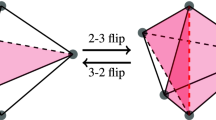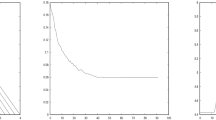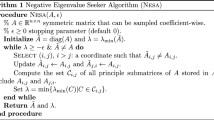Abstract
We characterize the performance of gradient- and Hessian-based optimization methods for mesh quality improvement. In particular, we consider the steepest descent and Polack-Ribière conjugate gradient methods which are gradient based. In the Hessian-based category, we consider the quasi-Newton, trust region, and feasible Newton methods. These techniques are used to improve the quality of a mesh by repositioning the vertices, where the overall mesh quality is measured by the sum of the squares of individual elements according to the aspect ratio metric. The effects of the desired degree of accuracy in the improved mesh, problem size, initial mesh configuration, and heterogeneity in element volume on the performance of the optimization solvers are characterized on a series of tetrahedral meshes.













Similar content being viewed by others
References
Babuska I, Suri M (1994) The p and h-p versions of the finite element method, basic principles, and properties. SIAM Rev 35:579–632
Berzins M (1997) Solution-based mesh quality for triangular and tetrahedral meshes. In: Proceedings of the 6th International Meshing Roundtable, Sandia National Laboratories, pp 427–436
Berzins M (1998) Mesh quality—Geometry, error estimates, or both? In: Proceedings of the 7th International Meshing Roundtable, Sandia National Laboratories, pp 229–237
Babuska I, Aziz A (1976) On the angle condition in the finite element method. SIAM J Numer Anal 13:214–226
Fried E (1972) Condition of finite element matrices generated from nonuniform meshes. AIAA J 10:219–221
Shewchuk J (2002) What is a good linear element? Interpolation, conditioning, and quality measures. In: Proceedings of the 11th International Meshing Roundtable, Sandia National Laboratories, pp 115–126
Freitag L, Ollivier-Gooch C (2000) A cost/benefit analysis for simplicial mesh improvement techniques as measured by solution efficiency. Int J Comput Geom Appl 10:361–382
Bank R, Sherman A, Weiser A (1983) Refinement algorithms and data structures for regular local mesh refinement. In: Stepleman R et al (eds) Scientific Computing. IMACS, Amsterdam, pp 3–17
Ollivier-Gooch C (1995) Multigrid acceleration of an upwind Euler solver on unstructured meshes. AIAA J 33:1822–1827
Rivara M (1984) Mesh refinement processes based on the generalized bisection of simplices. SIAM J Numer Anal 21:604–613
de L’isle E, George P (1995) Optimization of tetrahedral meshes. In: Babuska I, Henshaw W, Oliger J, Flaherty J, Hopcroft J, Tezduyar T (eds) Modeling, Mesh Generation and Adaptive Numerical Methods for PDEs, vol. 72. Springer, New York, pp 97–127
Edelsbrunner H, Shah N (1992) Incremental topological flipping works for regular triangulations. In: Proceedings of the 8th ACM Symposium on Computational Geometry, pp 43–52
Joe B (1989) Three-dimensional triangulations from local transformations. SIAM J Sci Stat Comp 10:718–741
Joe B (1995) Construction of three-dimensional improved-quality triangulations using local transformations. SIAM J Sci Comput 16:1292–1307
Amezua E, Hormaza M, Hernandez A, Ajuria M (1995) A method of the improvement of 3D solid finite element meshes. Adv Eng Softw 22:45–53
Canann S, Stephenson M, Blacker T (1993) Optismoothing: an optimization-driven approach to mesh smoothing. Finite Elem Anal Des 13:185–190
Parthasarathy V, Kodiyalam S (1991) A constrained optimization approach to finite element mesh smoothing. Finite Elem Anal Des 9:309–320
Knupp P, Freitag L (2002) Tetrahedral mesh improvement via optimization of the element condition number. Int J Numer Meth Eng 53:1377–1391
Freitag L, Plassmann P (2000) Local optimization-based simplicial mesh untangling and improvement. Int J Numer Meth Eng 49:109–125
Amenta N, Bern M, Eppstein D (1997) Optimal point placement for mesh smoothing. In: Proceedings of the 8th ACM-SIAM Symposium on Discrete Algorithms, pp 528–537
Zavattieri P (1996) Optimization strategies in unstructured mesh generation. Int J Numer Meth Eng 39:2055–2071
Brewer M, Freitag Diachin L, Knupp P, Leurent T, Melander D (2003) The Mesquite Mesh Quality Improvement Toolkit. In: Proceedings of the 12th International Meshing Roundtable, Sandia National Laboratories, pp 239–250
Nocedal J, Wright S (2006) Numerical optimization, 2nd edn. Springer, New York
Munson T (2007) Mesh shape-quality optimization using the inverse mean-ratio metric. Math Program 110:561–590
Cavendish J, Field D, Frey W (1985) An approach to automatic three-dimensional finite element mesh generation. Int J Num Meth Eng 21:329–347
Knupp P (2009) Sandia National Laboratories. Personal communication
Knupp P (2001) Algebraic mesh quality metrics. SIAM J Sci Comput 23:193–218
Armijo L (1966) Minimization of functions having Lipschitz-continuous first partial derivatives. Pac J Math 16:1–3
Kelley CT (2003) Solving nonlinear equations with Newton’s method. SIAM, Philadelphia
Sandia National Laboratories (2011) CUBIT Generation and Mesh Generation Toolkit, http://cubit.sandia.gov/
Si H, TetGen—a quality tetrahedral mesh generator and three-dimensional delaunay triangulator, http://tetgen.berlios.de/
Freitag L, Knupp P, Munson T, Shontz S (2004) A comparison of inexact Newton and coordinate descent mesh optimization techniques. In: Proceedings of the 13th International Meshing Roundtable, Sandia National Laboratories, pp 243–254
Diachin L, Knupp P, Munson T, Shontz S (2006) A comparison of two optimization methods for mesh quality improvement. Eng Comput 22:61–74
Shontz SM, Knupp P (2008) The effect of vertex reordering on 2D local mesh optimization efficiency. In: Proceedings of the 17th International Meshing Roundtable, Sandia National Laboratories, pp 107–124
Acknowledgments
The work of Shankar Prasad Sastry was funded in part by an Institute for CyberScience grant from The Pennsylvania State University. The work of Suzanne M. Shontz was funded in part by NSF grant CNS 0720749 and a Grace Woodward grant from The Pennsylvania State University.
Author information
Authors and Affiliations
Corresponding author
Additional information
A preliminary version of a portion of these results appeared in shortened form in the Proceedings of the 2009 International Meshing Roundtable.
Rights and permissions
About this article
Cite this article
Sastry, S.P., Shontz, S.M. Performance characterization of nonlinear optimization methods for mesh quality improvement. Engineering with Computers 28, 269–286 (2012). https://doi.org/10.1007/s00366-011-0227-9
Received:
Accepted:
Published:
Issue Date:
DOI: https://doi.org/10.1007/s00366-011-0227-9




